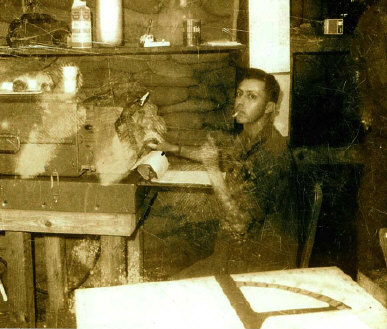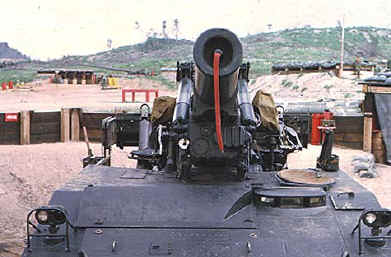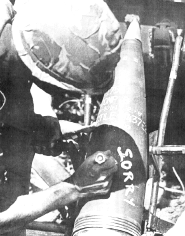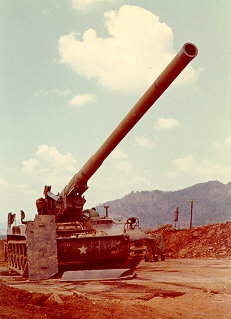|
"BIG GUNS ARE READY" |
|
|
Weapon Systems used by the |
|
| Written by: Dan Gillotti, 15th Historian |
|
|
Background recording compliments of Sgt James R. Claeys ("29er Charlie") Pleiku-An Khe (1969-70) 6/29 Arty & 2/11 Arty |
|
INDEX
IntroductionWhen the 7th Battalion (Bn), 15th Artillery (Arty) prepared for deployment to Vietnam in late 1966, it was armed with 8-inch Self-Propelled (SP) Howitzers designated as the US Army model M110. The 8-inch howitzer was the most accurate artillery weapon system in the US Army’s arsenal. It was capable of firing a 200 pound High Explosive (HE) projectile to a maximum range of 16,800 meters (10 miles). Its best known feature was its ability to hit "Point Targets" with consistent accuracy.
Many of the fire missions fired by the Indianheads of the Fighting Fifteenth were against heavily fortified and well-camouflaged enemy bunker complexes. In many instances, the infantry troops would walk right through an enemy bunker complex and would be caught in fierce enemy crossfire from the fortified bunkers. The most effective tactic to employ when this situation occurred was to pull the troops back and request a single-gun Precision Destruction Fire Mission. A trained Forward Observer (FO) could "walk" those big 200-pound rounds right in on top of the bunkers and neutralize them.
An 8-inch round tipped with a Delay or Concrete Piercing fuze was the most effective Bunker Buster in the Vietnam combat zone. However, because of the force of the large projectile, it was not safe to fire close to friendly troops as shell fragments could hit them. But in many instances the combat situation dictated the use of this weapon system near friendly troops after all the alternatives were considered.
The message sent to the troops on the ground during these situations was "Danger Close". This was not news to the Grunts (infantrymen), because when the enemy was about to overrun your position you will throw everything possible (including the kitchen sink) at him to stop him. "Danger Close" to the Grunts meant they could smell the "Nuoc Mam" fish sauce on the enemy’s breath.

Dan
Gillotti worked his FADAC computer
for over 36 hours during TET '68Technical
details
The M110 weighed approximately 52,000 pounds and was powered by a General Motors supercharged diesel engine with a top speed of approximately 35 miles per hour. A pump that ran off the main engine supplied hydraulic power. The hydraulic power was used to raise, lower, and traverse the tube, to lift and load the projectile into the breech, and to operate the huge hydraulic spade used to stabilize the weapon when it recoiled during firing.

M110 Howitzer
The chassis, platform, and power train used for this weapon system were extremely versatile. In a matter of a few hours, an experienced Ordnance crew could remove an 8-inch Howitzer barrel and replace it with a 175mm Gun Barrel. In October of 1967, C Battery, 7th Bn, 15th Arty was located at LZ Pony and became the first element of the Battalion to have two of its Howitzers retubed as 175mm Guns. When configured with a 175mm Gun barrel the system designation was then called the model M107.
I’ll attempt explain the differences between the two weapons in easily understood terms. The ballistic differences between a Howitzer and a Gun are that when an 8" Howitzer was fired, the round traveled along an "arching" trajectory until it hit the target. However, when a 175mm Gun was fired, it moved a 147 pound projectile at a very high velocity (approximately 3,000 feet per second), and consequently had a very "flat" trajectory.
With the addition of a 175mm Gun tube, the "Indianheads" were able shoot out to a range of 32,800 meters (20 miles) which was twice as far as the 8-inch Howitzers. Because of its high velocity, the 175mm Gun was used primarily against "Area Targets". Because of its high velocity the 175mm Gun had the reputation of being somewhat erratic. It could be temperamental if not used properly. But in the hands of a good gun crew, who serviced and maintained the weapon according to the specifications, kept the powder temperatures at a fairly constant level, kept the rounds clean, ensured a uniform depth of ram was achieved, kept the bore clean, and combined this with a good Fire Direction Center (FDC) crew and current meteorological data, you could in fact "hit the broad side of a barn".

An artilleryman sends a
personal message to the
enemy, "Sorry 'bout that!"
A 175mm Gun barrel only had a life of 300 Full Service Rounds when firing the maximum charge of Zone 3, and would then have to be replaced. Later in the Vietnam war, new tubes with longer lives were introduced extending their use to between 700 and 1,200 Full Service Rounds at Zone 3. Needless to say, the 7th Bn, 15th Arty became quite adept at quickly changing barrels after firing over 360,000 175mm and 8-inch rounds. If you needed accuracy and a "Big Bang", then you called for the 8-inch Howitzers. When you needed long range, you called on the 175mm Guns.

M107
in the LZ Diamondhead
motor pool for maintenance
Photo: Dave Holdorf
One fact you could take to the bank. . . when you called on the Indianheads of the Fighting Fifteenth for Heavy Artillery support you got "Deadly and Accurate Firepower." Allons!
Written by: Dan Gillotti, 15th Historian
Many thanks to Charles Hurst for sending these files!
You will need Adobe Acrobat Reader installed on your computer to view these files. There are several places to download a free version of the software, including the IRS web site and the link below.
8-Inch Howitzer Technical Manual
Excerpts
from: OPERATOR'S MANUAL
HOWITZER, HEAVY, SELF-PROPELLED
8-INCH, M110A2 - TM 9-2350-304-10
Headquarters,
Department of the Army, April 1990
Files
& Photo Credits: Charles Hurst
Background photo is the 10,000th round
being fired by the 7th Battalion/15th Field Artillery in 1967 at LZ
Diamondhead, RVN
Retubing
a 175mm gun
Photos: Don Aird




